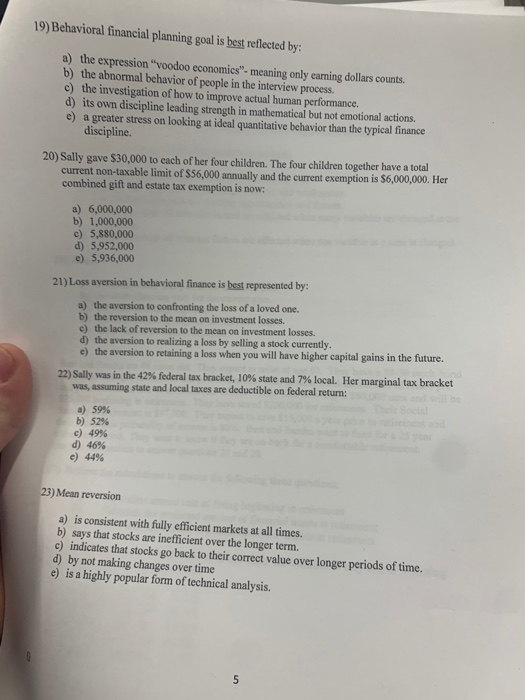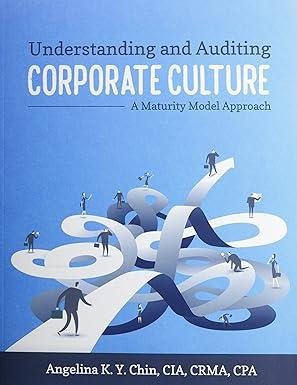questions 19-23

19) Behavioral financial planning goal is best reflected by: a) the expression "voodoo economics"- meaning only caming dollars counts. b) the abnormal behavior of people in the interview process. c) the investigation of how to improve actual human performance. d) its own discipline leading strength in mathematical but not emotional actions. e) a greater stress on looking at ideal quantitative behavior than the typical finance discipline. 20) Sally gave $30,000 to each of her four children. The four children together have a total current non-taxable limit of $56,000 annually and the current exemption is $6,000,000. Her combined gift and estate tax exemption is now: a) 6,000,000 b) 1,000,000 c) 5,880,000 d) 5,952,000 e) 5,936,000 21) Loss aversion in behavioral finance is best represented by: a) the aversion to confronting the loss of a loved one. b) the reversion to the mean on investment losses. c) the lack of reversion to the mean on investment losses. d) the aversion to realizing a loss by selling a stock currently. e) the aversion to retaining a loss when you will have higher capital gains in the future. 22) Sally was in the 42% federal tax bracket, 10% state and 7% local. Her marginal tax bracket was, assuming state and local taxes are deductible on federal return: a) 59% b) 5296 c) 49% d) 46% e) 44% 23) Mean reversion a) is consistent with fully efficient markets at all times. b) says that stocks are inefficient over the longer term. c) indicates that stocks go back to their correct value over longer periods of time. d) by not making changes over time e) is a highly popular form of technical analysis. 19) Behavioral financial planning goal is best reflected by: a) the expression "voodoo economics"- meaning only caming dollars counts. b) the abnormal behavior of people in the interview process. c) the investigation of how to improve actual human performance. d) its own discipline leading strength in mathematical but not emotional actions. e) a greater stress on looking at ideal quantitative behavior than the typical finance discipline. 20) Sally gave $30,000 to each of her four children. The four children together have a total current non-taxable limit of $56,000 annually and the current exemption is $6,000,000. Her combined gift and estate tax exemption is now: a) 6,000,000 b) 1,000,000 c) 5,880,000 d) 5,952,000 e) 5,936,000 21) Loss aversion in behavioral finance is best represented by: a) the aversion to confronting the loss of a loved one. b) the reversion to the mean on investment losses. c) the lack of reversion to the mean on investment losses. d) the aversion to realizing a loss by selling a stock currently. e) the aversion to retaining a loss when you will have higher capital gains in the future. 22) Sally was in the 42% federal tax bracket, 10% state and 7% local. Her marginal tax bracket was, assuming state and local taxes are deductible on federal return: a) 59% b) 5296 c) 49% d) 46% e) 44% 23) Mean reversion a) is consistent with fully efficient markets at all times. b) says that stocks are inefficient over the longer term. c) indicates that stocks go back to their correct value over longer periods of time. d) by not making changes over time e) is a highly popular form of technical analysis








